|
|
|
Sort Order |
|
|
|
Items / Page
|
|
|
|
|
|
|
| Srl | Item |
| 1 |
ID:
134050
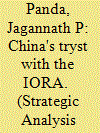

|
|
|
|
|
| Publication |
2014.
|
| Summary/Abstract |
Engaging with a multilateral body requires constructive foreign policy forethought, especially for a country that is not a fully fledged member of that body. China's overtures to the Indian Ocean Rim Association (IORA) exemplify this approach. The Indian Ocean and India are the two most immediate elements in China's policy approach to the IORA. With 20 member states, extra-territorial major powers as important dialogue partners, and the increasing importance of energy politics in the region, the IORA today is a significant multilateral body in China's calculus. Beijing's involvement with the IORA bespeaks the construct and strategy of a great power. For India, China's power construct in this matter poses three challenges: Beijing as a maritime power; Beijing as an economic power; and Beijing as a polygonal power.
|
|
|
|
|
|
|
|
|
|
|
|
|
|
|
|
| 2 |
ID:
130648


|
|
|
|
|
| Publication |
2013.
|
| Summary/Abstract |
The committee's report has highlighted the diversity of the countries of the Indian Ocean Rim and the multiple ways it which these states can be categorised. This diversity and the lack of a single agreed definition of the 'Indian Ocean Rim' has created a significant challenge for the development of policy, from both an Australian and a regional perspective. Australia's approach to trade in the Indian Ocean Rim is largely bilateral; defence and strategic relations are based on single issue groupings; and aid to the region is predominately provided under the auspices of the United Nations. Evidence gathered in relation to the Indian Ocean Rim Association for Regional Co-operation (IOR-ARC) demonstrates clearly that diversity in the region - both economic and political - has created inertia in the region's main organisation.
|
|
|
|
|
|
|
|
|
|
|
|
|
|
|
|
| 3 |
ID:
130877
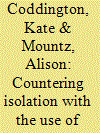

|
|
|
|
|
| Publication |
2014.
|
| Summary/Abstract |
Governments detain asylum seekers on islands across the Indian Ocean region, including Australia's Christmas Island, Papua New Guinea's Manus Island, Nauru, and across the Indonesian archipelago. Scholars and advocates alike have shown that the ambiguous jurisdiction and complex legal migration statuses that emerge in these areas, as well as their remote location and isolation, contribute to their popularity as sites of migrant detention. The negative effects of isolation and remoteness on migrants' physical and mental health, as well as their legal outcomes, have been well documented. We argue, however, that detainees and others are countering the effects of isolation with the use of technology. Ethnographic research conducted on the islands within Australian and Indonesian migrant detention networks suggests that asylum seekers detained in remote sites across the region are combating the isolation of detention with the use of mobile phones, internet access, and social media networks. They communicate with friends, relatives, legal representatives, advocates, activists, and members of the public beyond prison walls to transmit information, facilitate advocacy inside and outside of detention facilities, and construct transnational support networks. In turn, punitive policies to discipline asylum seekers by limiting methods of communication threaten these efforts.
|
|
|
|
|
|
|
|
|
|
|
|
|
|
|
|
| 4 |
ID:
130873
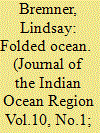

|
|
|
|
|
| Publication |
2014.
|
| Summary/Abstract |
This paper presents experimental research on the Indian Ocean being undertaken within the context of what has been termed architecture's contemporary geographic turn. It investigates how oceanic practices and protocols fold into spatial and architectural products on land, figuring both sea- and land-based logics. It frames this ocean through three tropes: as contact zone, with which are associated ideas of creolisation, transnationalism, entanglement, compaction and multi-polarity; as circulator with which are associated ideas of connectivity, passage, lane, route, choke point, network, port, dock and deposit; and as ecology, with which are associated ideas of liquidity, cycle, rhythm and climate change. The paper introduces these tropes and investigates sites brought into focus through them, highlighting the wider global dynamics or processes they reveal. It concludes with provisional thoughts about what these amphibious sites offer for understandings of architecture and urbanism in today's hyper-articulated, globalised world.
|
|
|
|
|
|
|
|
|
|
|
|
|
|
|
|
| 5 |
ID:
130643


|
|
|
|
|
| Publication |
2013.
|
| Summary/Abstract |
A rising Africa has caught the attention of the world not merely because of its vast natural resources but also because it is the economically fastest growing continent. The article argues that, as Africa gains prominence, the roles of China and India have come into focus. New Delhi's current policy is quite different from that it pursued in the post-independence era, which was focussed on the limited political agenda of anti-colonialism. Even as its interests in the Indian Ocean rapidly grow, its great power ambitions are increasing backed by a burgeoning economy. This has necessitated a new a new policy of engagement that is expansive and multifaceted, encompassing political, economic and strategic dimensions. India maintains that its robust economic relationship is part of South-South cooperation and hence mutually beneficial, for it is aimed at capability and institution building. While economic and political aspects continue to dominate the academic discourse, the Indian Ocean is beginning to become a significant factor in India's Africa policy, even as this ocean acquires enormous geostrategic and economic
|
|
|
|
|
|
|
|
|
|
|
|
|
|
|
|
| 6 |
ID:
130641
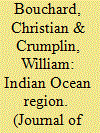

|
|
|
|
|
| Publication |
2013.
|
| Summary/Abstract |
The African littoral of the Indian Ocean is a significant part of the Indian Ocean region. In the context of the IOR-ARC, focus is given to the African littoral of the Indian Ocean Rim, which consists of 10 states plus three French island territories. However, an African Indian Ocean extended area of 24 states plus the French islands can be identified as part of the broader Indian Ocean region, to which we refer as the African Indian Ocean littoral and hinterland. This highlights the fact that the African land-locked states represent a pertinent and significant dimension to the relation between the African littoral and the rest of the Indian Ocean region. Overall, this African Indian Ocean littoral and hinterland is a region of low socio-economic development facing many challenges. Nonetheless, it is a region on the move, and some substantial improvements can be expected during the entire twenty-first century. The potential, and perhaps even expected outcome of a much larger and healthier population, a better performing and more open economy, and an increase in and more efficient management of maritime activities will set the scene for the rising significance of the African littoral to both the Indian Ocean region and the Indian Ocean Rim, thus also increasing its geopolitical and geostrategic significance.
|
|
|
|
|
|
|
|
|
|
|
|
|
|
|
|
| 7 |
ID:
133696


|
|
|
|
|
| Publication |
2014.
|
| Summary/Abstract |
The dynamics of the Indian Ocean region have great economic and political implications - particularly for South Asia. It has always been an arena of power struggle. it has become much more vibrant in the post Cold War scenario, particularly after the collapse of the Soviet Union as a dominant player in world politics. As far as India is concerned, it is considered to be the largest and the most geostrategically located country in the Indian Ocean, with a substantially long coast line. Therefore, any disturbance to the stability of the Indian Ocean region has a direct impact on India's security. Indian Ocean being the only ocean named after a particular country has been viewed as India's backyard by Indian strategic thinkers.
|
|
|
|
|
|
|
|
|
|
|
|
|
|
|
|
| 8 |
ID:
128631


|
|
|
|
|
| Publication |
2013.
|
| Summary/Abstract |
As the fulcrum of economic growth tilts towards the dynamic eastern economies in the 21st century, the Indian Ocean Region (IOR) has assumed strategic importance. China is making inroads in to the IOR island states with tis weiqi strategy to safeguard and further its interest with its realpolitik of the string of pearls. The author is Vise President of the Indian Maritime foundation and a former DNI and DNO at NHQ as well as author of A Nation and its Navy at War
|
|
|
|
|
|
|
|
|
|
|
|
|
|
|
|
| 9 |
ID:
130645
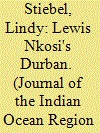

|
|
|
|
|
| Publication |
2013.
|
| Summary/Abstract |
Lewis Nkosi, the late exiled South African writer, and the city of Durban, an extended urban space of an estimated 3 million inhabitants, are incontrovertibly linked. This sprawling Indian Ocean town is where Nkosi was born, where he was educated as a small child, where he started his working career, and where he was finally buried on 10 September 2010. Given the centrality of Durban to Nkosi's life story, it is unsurprising that this city periodically appears in Nkosi's writing, both fictional and non-fictional, as a geographical 'setting' but also as a symbol of political change in South Africa. This paper, then, begins an evaluation of the role of 'Durban' and the Indian Ocean in the life and work of Nkosi, drawing from his novel Mating birds, and also from a little known article published in a Swiss newspaper, translated into German. Durban emerges from these various sources as a city in flux, a place of startling contrasts, a melting pot of peoples and a dream space called 'home' for this celebrated writer.
|
|
|
|
|
|
|
|
|
|
|
|
|
|
|
|
| 10 |
ID:
133675
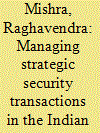

|
|
|
|
|
| Publication |
2014.
|
| Summary/Abstract |
The Indian Ocean Region (IOR) presents a unique tapestry of correspondences and divergences, positive and negatives, in an era of flux with world order, most likely, on the cusp of a systemic reordering. The geo-strategic salience of this region, as part of a larger global maritime continuum, has also increased. Strategic hedging behaviour by major stakeholders, resident and non-resident alike; besides securitisation of geo-political discourse that focuses on competitive aspects also present distinctive challenges for evolving a cooperative framework tailored to regional needs. The key issues examined for obtaining a pan-regional politico-strategic rapprochement are the tenets of critical geopolitics, game theory, geography, context and the efficacy of existing multilateral mechanisms, especially Indian Ocean Rim Association (IORA). The overall aim is to examine the various intertwined threads for formulating an inclusive and multi-sectoral maritime security framework with an IOR contextualisation.
|
|
|
|
|
|
|
|
|
|
|
|
|
|
|
|
| 11 |
ID:
132929
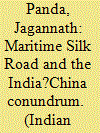

|
|
|
|
|
| Publication |
2014.
|
| Summary/Abstract |
India-China maritime dynamics are witnessing new developments and balance of power politics. Beijing's economic and maritime posture continues to emerge as a challenge for India. In fact, underlying China's Maritime Silk Road strategy is an orderly diplomatic, economic, and maritime quest for power that India must take note of. A core aim behind this strategy is to re-brand China as an economic, political and maritime power in IOR as well as in the neighbouring region. In official parlance, this enterprise is intended to integrate Beijing's existing levels of cooperation in the region, and to look beyond. As Hua Chunying, spokesperson of the Chinese Foreign Ministry, stated on 13 February 2014, "This is an initiative and idea of cooperation, which will help integrate all the on-going cooperation programmes, especially those in connectivity with the concept and spirit of the ancient Silk Road.". India and other countries need to take note and respond to this discourse.
|
|
|
|
|
|
|
|
|
|
|
|
|
|
|
|
| 12 |
ID:
126370
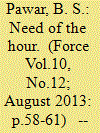

|
|
|
|
|
| Publication |
2012.
|
| Summary/Abstract |
India today faces many threats and challenges to its external and internal security, the foremost being the long festering dispute over J&K with Pakistan and the unresolved territorial and boundary dispute with China. The recent assertiveness of China - DBO standoff - its nexus with Pakistan, its 'string of pearls' strategy to surround India with naval bases in northern Indian Ocean Region (IOR) and its military presence in the Gilgit-Baltistan area of Pak Occupied Kashmir and the Gwador Port, are a serious cause of concern for the Indian military and do not augur well for long-term peace and stability. The insurgencies in J&K and the Northeast fuelled by Pakistan and China respectively, the Maoist threat in India's heartland and the deteriorating security environment in the Af-Pak region has further vitiated India's strategic environment. The prevailing strategic environment has forced India's armed forces to prepare for the possibility of a 'two front' war in any future conflict on our northern and western borders.
|
|
|
|
|
|
|
|
|
|
|
|
|
|
|
|
| 13 |
ID:
130872
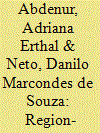

|
|
|
|
|
| Publication |
2014.
|
| Summary/Abstract |
Far from being 'naturally' delineated by geography or bound solely through shared culture, regions are actively constructed by states and other actors pursuing specific interests. In this article, we analyse the region-building efforts of two rising powers - Brazil and India - as they work to project power and enhance their influence within the Atlantic and Indian oceans, respectively. Through a comparison of their behaviours within their maritime spaces - including naval build-up, international cooperation, and efforts to revive institutions such as ZOPACAS and IOR-ARC - we argue that Brazil and India are paying increasing attention to oceanic rims, albeit for somewhat disparate reasons. While India is increasingly concerned with the role of China within the Indian Ocean, for which it has had to rely on US support, Brazil is primarily driven to protect its oil and to minimise the role of the US and NATO in the South Atlantic. In both spaces, however, the rise of so-called non-traditional threats, including piracy, has further motivated these states' maritime power strategies. The analysis suggests that, within the context of the post-Cold War period, rising powers have begun redefining their strategic regions in terms of their maritime perimeters as a way to project power and influence beyond their continental vicinities.
|
|
|
|
|
|
|
|
|
|
|
|
|
|
|
|
| 14 |
ID:
130874


|
|
|
|
|
| Publication |
2014.
|
| Summary/Abstract |
Maritime security in the Indian Ocean Region (IOR) has become a paramount consideration; a range of traditional and non-traditional security challenges largely converge at sea. Risk-based processes offer the potential to engage in a positive, constructive and non-confrontational approach that will help to identify collective and cooperative security strategies. Analysing the evolving maritime security risk context provides a powerful tool for understanding common risks and vulnerabilities that affect regional and extra-regional actors with interests in the IOR. This can provide the impetus for diverse actors, primarily states, to cooperate to advance common objectives and protect shared interests without significantly compromising territorial integrity or sovereignty, against a range of risks that no single actor has the ability to mitigate. Commissioning a multinational, multi-disciplinary team of experts to conduct a regional strategic risk assessment, with a specific focus upon maritime security, should be a priority. Maritime security cooperation in the IOR could, if managed astutely and prudently, bind a diverse and largely disaggregated region
|
|
|
|
|
|
|
|
|
|
|
|
|
|
|
|
| 15 |
ID:
133069
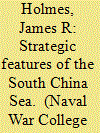

|
|
|
|
|
| Publication |
2014.
|
| Summary/Abstract |
The South China Sea is a semienclosed sea at the intersection between East Asia and the Indian Ocean region. It exhibits characteristics similar to the Mediterranean Sea and the Caribbean Sea, as well as some revealing differences. Both the similarities and the differences commend sea-power theorist Alfred Thayer Mahan's analysis of the Gulf of Mexico and the Caribbean Sea to presentday students and practitioners of maritime strategy. Mahan classified strategic features-especially prospective sites for naval stations-by their positions, strengths, and resources. This article adds a metric to his analytical template, namely, the state of relations with countries that host naval bases. He applied much the same framework to narrow seas, such as international straits, while also sizing up these passages' widths, lengths, and difficulty of transit. Here too an element warrants adding, namely, the underwater terrain-its topography and hydrography.
|
|
|
|
|
|
|
|
|
|
|
|
|
|
|
|
| 16 |
ID:
128662
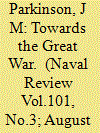

|
|
|
|
|
| Publication |
2013.
|
| Summary/Abstract |
A century ago, in August 1913, the Commander in Chief, China Station was Vice Admiral Martyn Jerram. From England via the Atlantic, North America and the Pacific he had arrived at Hong Kong from Vancouver on 14 March 1913 in the CPR steamer empress of India (5,943 grt). There, on 29 March 1913, he assumed command of the station in succession to Admiral Sir Alfred Winsloe who on that day sailed for England in the P and O SS India (7,911 grt.).As befits the era, the wade-Giles from Romanisation is used where relevant.
|
|
|
|
|
|
|
|
|
|
|
|
|
|
|
|
|
|
|
|
|